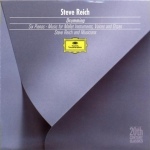I’ve known Steve Reich’s hypnotic Music for Mallet instruments, voices and organ ever since my second year of college, when someone in the sixth form made me a recording, together with Six Pianos, Large Ensemble and Vermont Counterpoint, which pretty much defined my musical love ever since. That means I’ve known the piece for well over … *coughs, mumbles into hand… years; it’s gone through most of the recorded formats I can think of – cassette, CD, mini-disc, mp3, DVD – and yet I am still hearing new aspects of the piece when I listen to it.
This may, of course, be due to several factors; different recordings have different values, perhaps highlighting different lines or patterns compared to others; seeing the piece performed means the ear can be draw to different lines by virtue of the eye being drawn by some aspect of the visual spectacle; and listening in the car, immersed in the sound emanating from speakers fore and aft, is a very different experience to listening through headphones.
 But I’m still being surprised and delighted by the discovery of patterns I hadn’t heard before, textural shifts I’d not noticed, harmonies that are altered by suddenly hearing a new pedal-point or sustained note. There’s a wonderful, deft live performance by Alarm Will Sound, broadcast as Reich at the Roxy that I’ve watched often, which showed me new material by my watching the performers in actin and highlighting certain textural aspects I hadn’t discerned previously.
But I’m still being surprised and delighted by the discovery of patterns I hadn’t heard before, textural shifts I’d not noticed, harmonies that are altered by suddenly hearing a new pedal-point or sustained note. There’s a wonderful, deft live performance by Alarm Will Sound, broadcast as Reich at the Roxy that I’ve watched often, which showed me new material by my watching the performers in actin and highlighting certain textural aspects I hadn’t discerned previously.
It’s often said that one of the signs of a masterpiece, in any artistic medium, is the work’s ability to sustain the repeated experience and yield new elements. If this is true, then Reich’s piece stands as an example of just such a work.
Filed under: Contemporary music, Minimalism, Notes on music | Tagged: Alarm Will Sound, minimalism, Steve Reich | Leave a comment »


 I think I may have found it. A disc brought out by The Change-Ringing Handbell Group in 2009 of various bell-ringing patterns, normally rung by church bells but here realised by handbells instead, presents some shimmering cascades of sound, like a cross between minimalism and sacred music: process music for the ecclesiastically minded.
I think I may have found it. A disc brought out by The Change-Ringing Handbell Group in 2009 of various bell-ringing patterns, normally rung by church bells but here realised by handbells instead, presents some shimmering cascades of sound, like a cross between minimalism and sacred music: process music for the ecclesiastically minded. The lone cries of the seagull towards the end, the fractured spoken passages, all reinforce the idea of loneliness, of the inability to communicate, of being apart.
The lone cries of the seagull towards the end, the fractured spoken passages, all reinforce the idea of loneliness, of the inability to communicate, of being apart.

